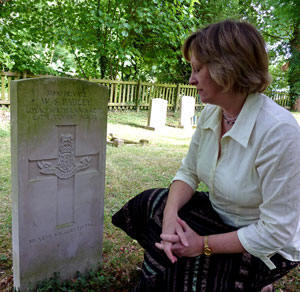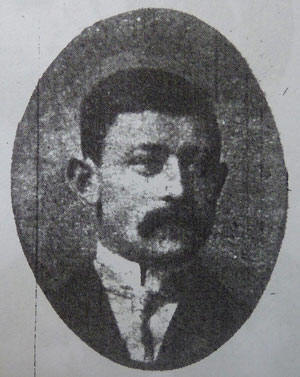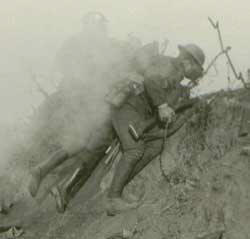|
Louise
Thompson uncovers |
History |
 |
Louise
writes "I've always
had a fascination with my own family history, which my
father researched many years ago, before the age of computers.
About 5 years ago I took up the challenge of finding my
husband's
ancestors and soon became hooked on genealogy. An
interest in history led me to look at the lives of
several ancestors who had fought in WW1. The loss of two
of my Grandmother's
brothers in the Great War had a profound effect on her
family, compounded by the fact they have no known grave.
My father's
father died in May 1940 a few miles short of Dunkirk,
his grave is in the churchyard of a small rural village
in France. When I happened on Pte. Pauley's grave in St Helen's Churchyard I felt compelled to find out something about his life and how he died." Louise lives in Little Eversden. |
| This account is
assembled from Louise's research notes. (Ed.) There was a wedding in St Helen's church, Little Eversden, in December 1869. The bride, Susan Adams, was just 21, the eighth child of aging parents. Robert Pauley, her husband, was 27. He came from Stotfold. After the wedding the couple moved in with Susan's mother and father in their cottage in Harlton Road. |
| Susan and
Robert's first child,
Emily, was born within two years. The family
grew steadily. Sidney William, number four, was
born in 1885. Susan was widowed when Sidney was
just 10 years old. Her first child, Emily, had
died aged 4. Page, the third, died aged 14 in
1894. Sidney's brother, George, was to die in
1901. The little cottage near The Plough
lived with sadness. There is a photograph in Quiet Lanes and Orchard Ends taken around 1890. It is probable that Sidney is one of the younger children pictured. Had he speculated on his future at this time, no doubt he would have expected to spend his life, as his father had, working in the fields around Little Eversden. By 1901 he was indeed working as a fruit grower labourer. Then he met Elsie. By 1911 he was married with a daughter, Kathleen. They lived with his mother. Walden was born in 1915. Sidney was thirty years old. Life cannot have been easy. Nevertheless, it had its established rhythms dominated by the seasons, traditions, and the necessities for survival. Ups and downs, certainly, but compensations in village life. Nothing can have prepared him and his family for the year ahead. This is how Sidney Pauley's final year is recorded: |
 Sidney Pauley Photo courtesy of The Cambridgeshire Collection (Click) |

"Over the top" from |
He enlisted in July 1916 at Bury St.Edmunds (originally with the Royal Fusiliers, number 3369), his residence is given as Blackwell, Berks. After a period of training he was sent to France, he was wounded at the Battle of Arras and died of his wounds on 26th July 1917. The death is registered at Woolwich district, the address given in the National Roll of the Great War is 40 Davis Road, Acton, W3. He was serving with the Loyal North Lancashire Regiment at the time of his death. Service number 35890. They were part of the 10th (Service) Battalion, 37th Division, which served on the Western Front. At the Battle of Arras the 37th Division was part of the Third Army under Allenby, the significant battles being, the First Battle of the Scarpe, 9-14 April 1917, the Second Battle of the Scarpe, 23-24 April 1917, and the Battle of Arleux, 28-29 April 1917. He was entitled to the Victory Medal & the British War Medal. |
|
The Eversden correspondent of The Cambridge Chronicle and University Journal reported on Wednesday April 25th 1917 "News has come that three more of our 'boys' have been wounded: Pte Pauley in both legs, with one broken, and Pte. G Roberts, who is wounded for the second time, this time in his shoulder. And also Pte. Clark." (See bottom of page.)
The edition of Wednesday August 15th 1917 reported "We regret to announce the sad news that Pte. Sidney Pauley, who prior to joining up was sexton at Eversden, has died of the wounds received three months ago. He was shot in both legs, one very badly, but it was hoped at one time that he was progressing favourably. Much sympathy was felt for his wife and mother. The funeral took place at Little Eversden Church on Wednesday, amid pouring rain, the Rev. L. Iggulden officiating. There were some very nice wreaths. On Sunday special forms of prayer were offered in church at the beginning of the fourth year of the war, also in memoriam of Pte. Sidney Pauley. The Rev. Gardiner Smith, of Comberton, preached a splendid sermon from 1 Cor. x. 13., and alluded to the loss of Pte. Pauley, who was much respected."
Sidney's mother lived on in the cottage near The Plough until 1929. It is not known how Elsie and the children, Kathleen and Walden, survived without Sidney whose life was so cruelly cut short. St Helen's church, whose bells probably rang for Susan and Robert's wedding, now shelters their son's war grave under the trees on the Eastern side, scant record of a life sacrificed. |
|
For a soldier's account of the Battle of Arras click http://www.culpitt-war-diary.org.uk/CH_10.htm |
| Private Clark
had been wounded for the second time in the chest and right thigh.
Below is part of a letter he sent to his mother: "I had a busy time just before I was hit. There came a shell over and buried one of our fellows and partly buried me, but I managed to get myself out, and set to work and dug the other fellow out alive, although he was wounded in the arm. Just as I got him out another shell came and buried another fellow on the other side of me. I dug for all I was worth, and got him out alive; shells were buzzing all round me, but, thank God, none of them hit me. When I had finished digging them out, one of my officers came and patted me on the shoulder and called me a good fellow for what I had done and would see that I was all right when we got back again. My name would have gone into the Commanding Officer, and no doubt I should have got something for what I had done, and I could hardly speak myself. I dug for all I was worth but in less than five minutes, over came another shell. I got hit, and when I looked round I saw my officer laid out flat. I had a look at him, and saw that he was gone. I could do no more, so I made for the dressing station as fast as I could; I didn't stop to get the third one. My name was 'Johnny Walker', or rather 'runner', until I got out of shell-range." |